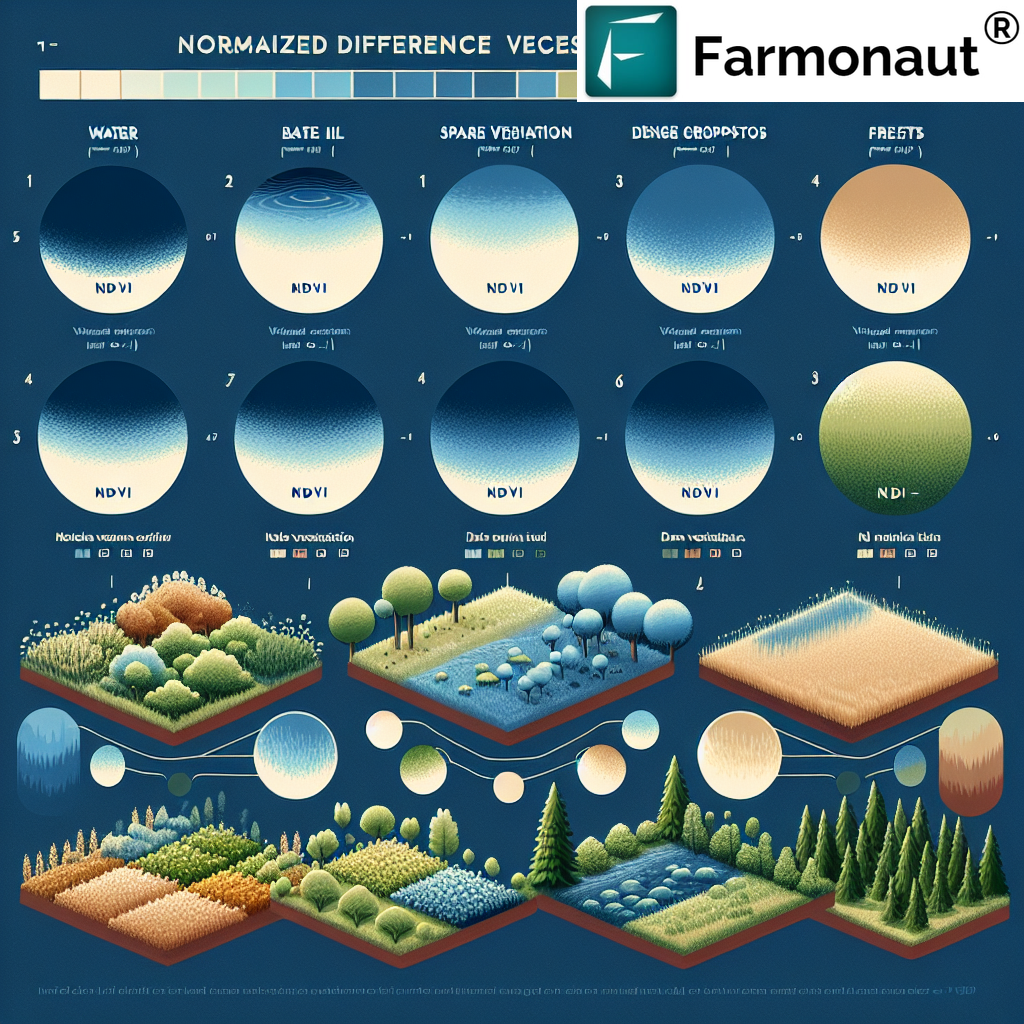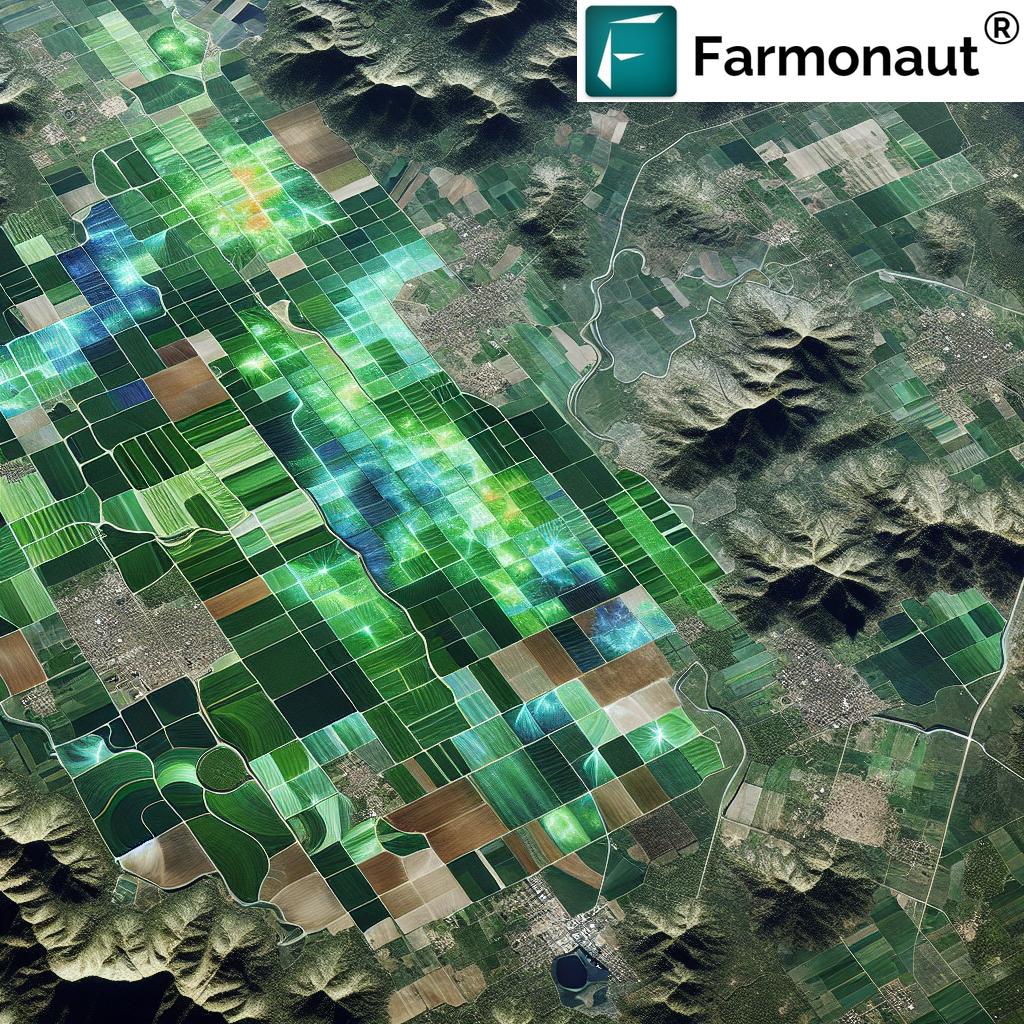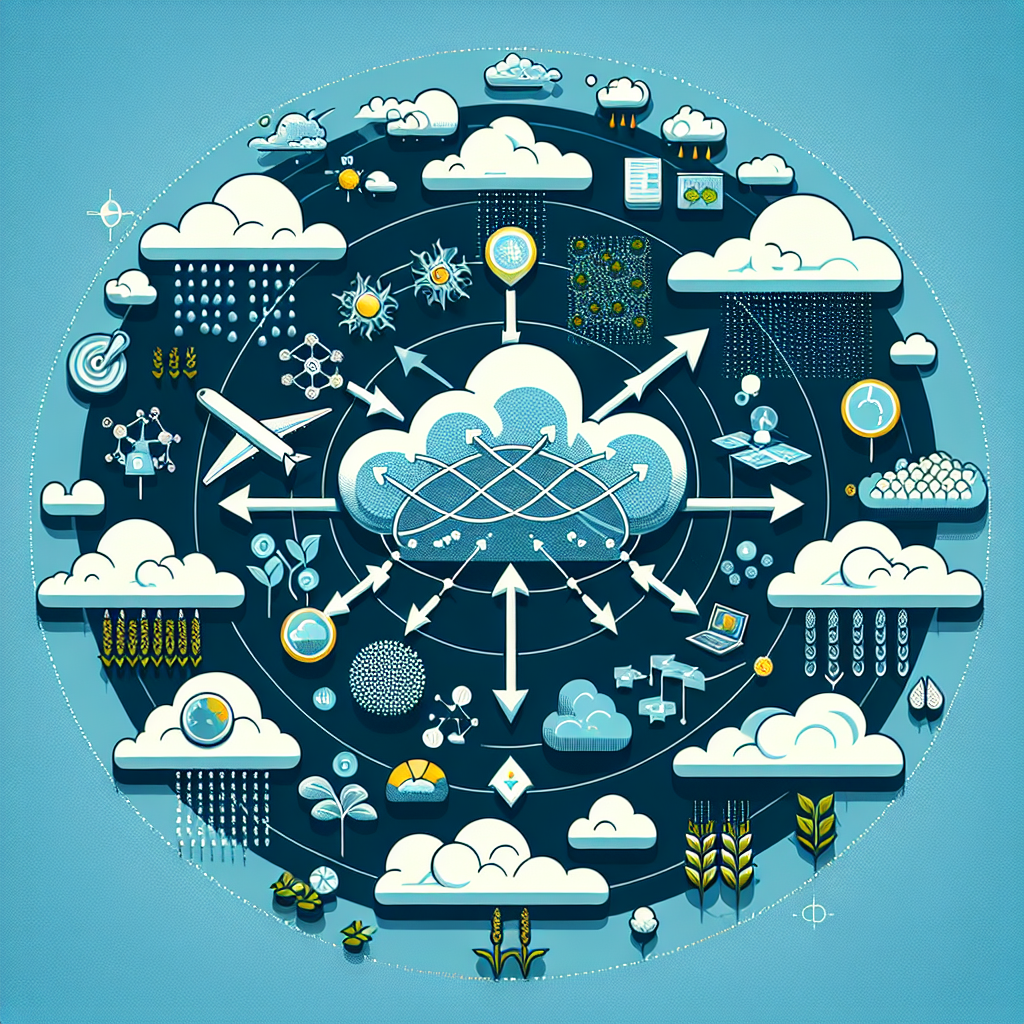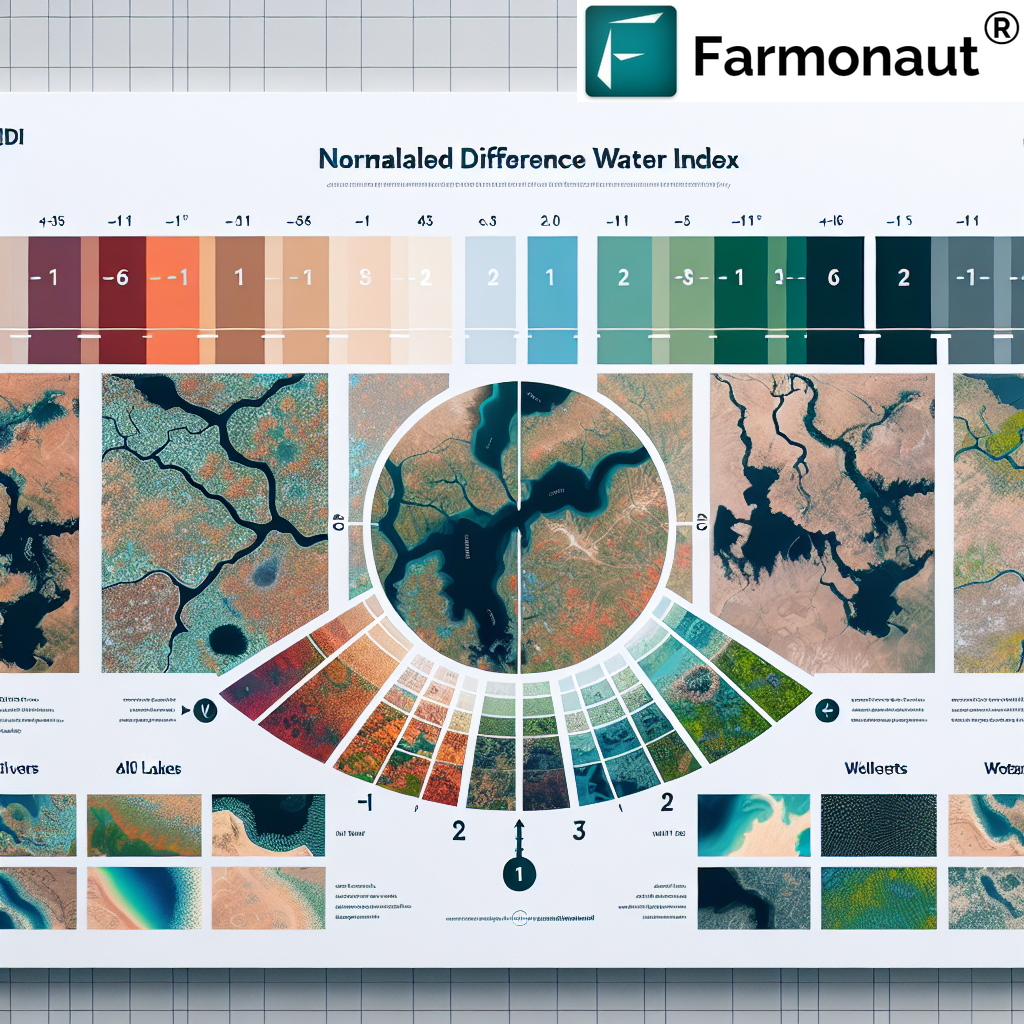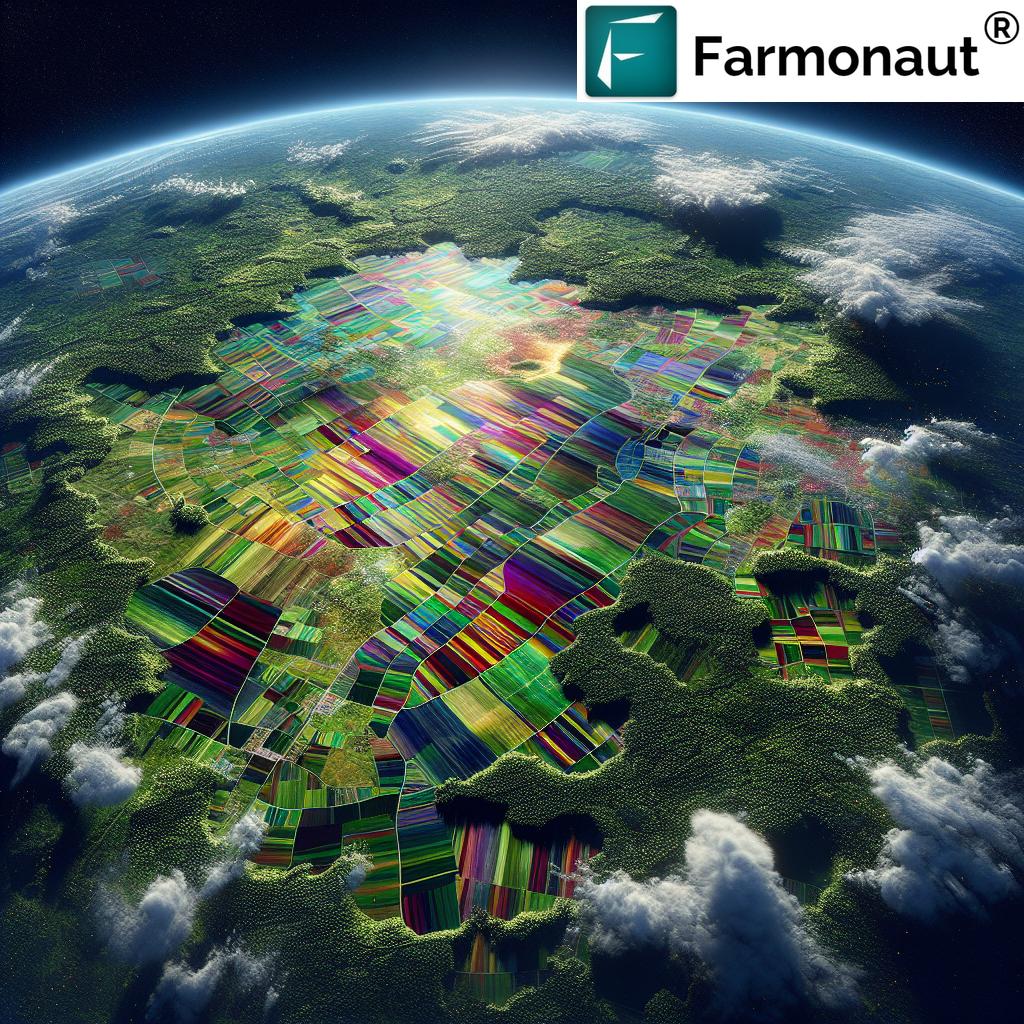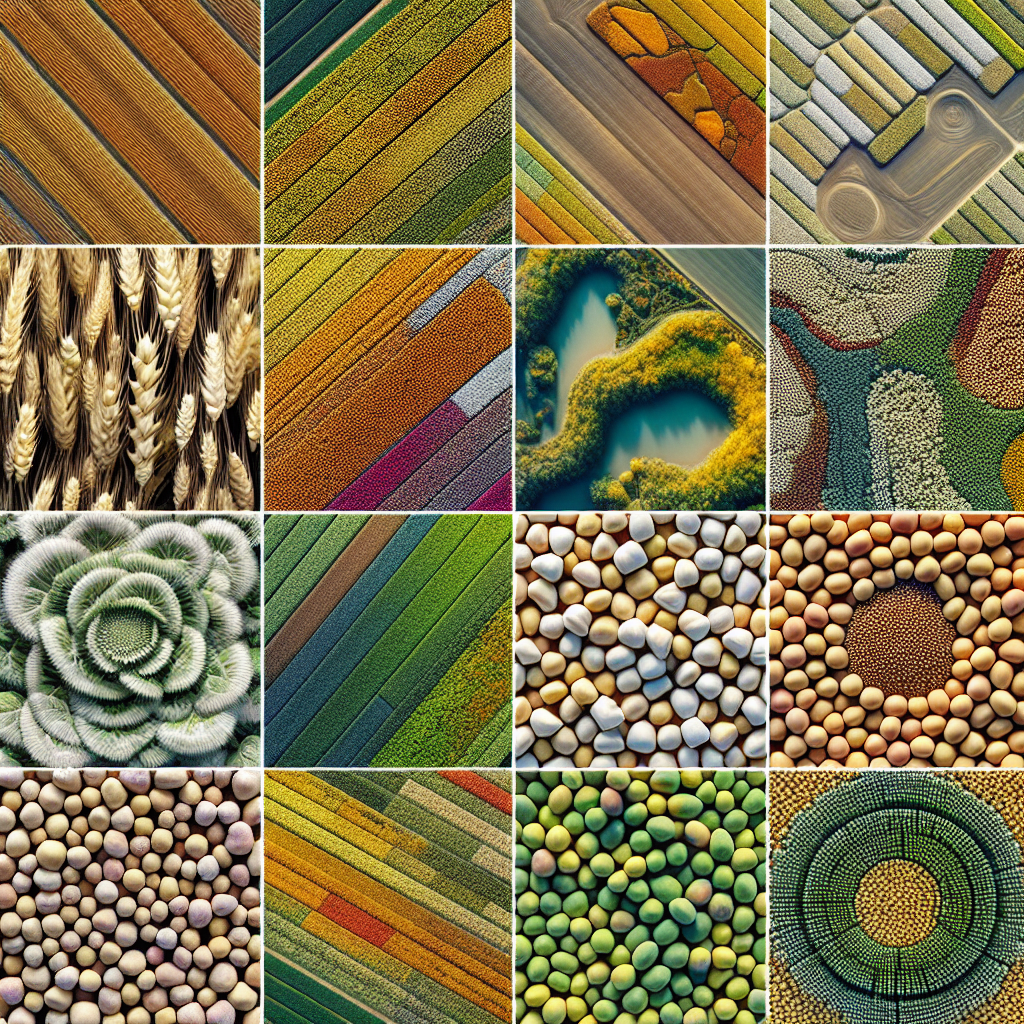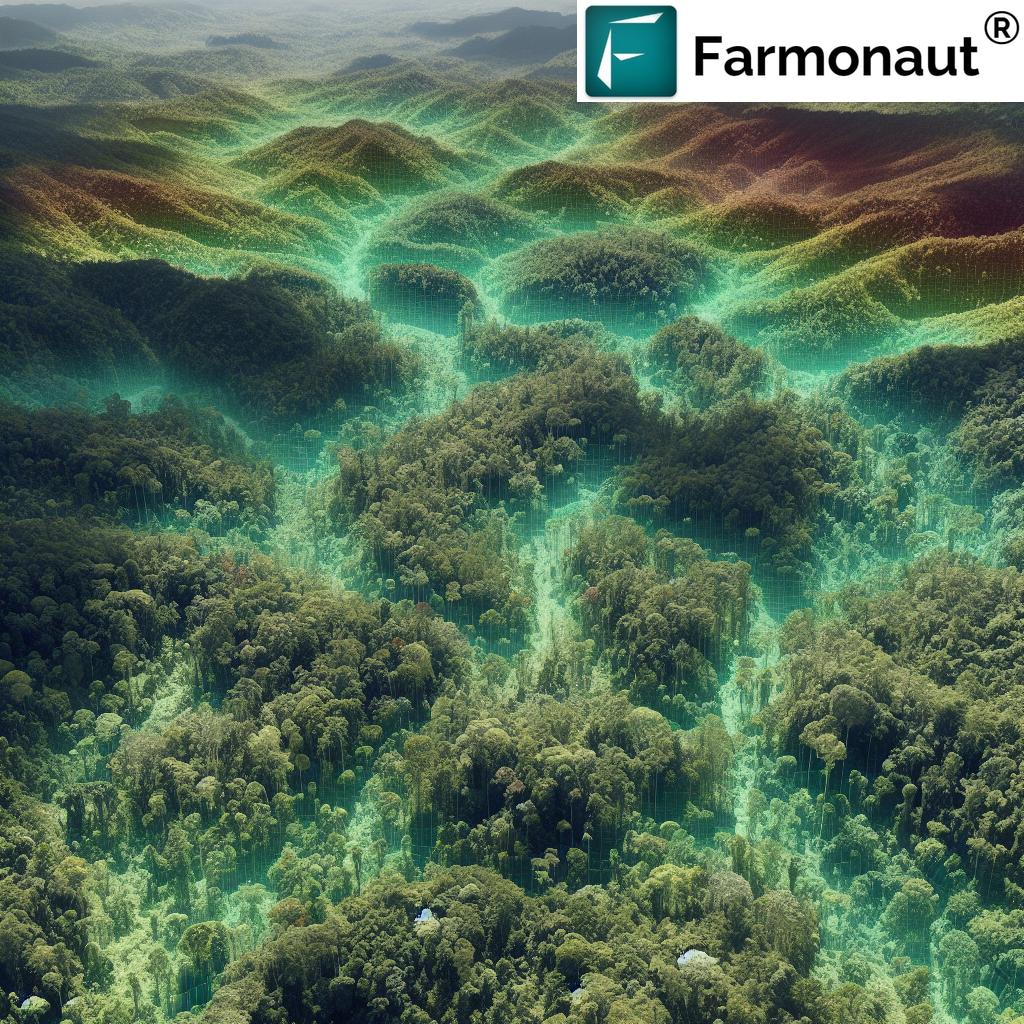Content Aggregation via Satellite: 3 Ceres Satellites Fueling the Modern Agricultural Data Revolution
“3 Ceres satellites can scan over 2 million hectares of farmland daily for actionable agricultural insights.”
Table of Contents
- Introduction: Content Aggregation via Satellite – A New Era in Agriculture
- Decoding Content Aggregation via Satellite: Concepts and Context
- Unveiling the 3 Ceres Satellites in a Row: Star Performers of Agricultural Data Aggregation
- The “Three in a Row” Orbital Configuration Explained
- Comparative Feature Table: Ceres Satellites Driving Agricultural Excellence
- Core Applications: How Satellite Content Aggregation Boosts Modern Farming
- Precision Agriculture: The Power of Content Aggregation via Ceres Satellites
- Early Warning Systems: Timely Interventions via Aggregated Satellite Streams
- Sustainability and Resource Management Empowered by Ceres Content
- Supply Chain and Market Efficiency through Comprehensive Satellite Data
- Farmonaut: Integrating Advanced Satellite Content Aggregation into Everyday Agronomy
- Technological Advances and Benefits: The Ceres Satellite Array
- Overcoming Challenges and Charting the Roadmap for the Future
- FAQ: Content Aggregation via Satellite and the Ceres Satellite Array
- Final Thoughts: The Future of Farming Powered by Content Aggregation via Satellite
Introduction: Content Aggregation via Satellite – A New Era in Agriculture
In 2025, the agricultural sector is being revolutionized by new technologies. One of the most transformative advancements is content aggregation via satellite. By leveraging the sophisticated 3 Ceres satellites in a row configuration, unprecedented agricultural data and comprehensive management insights are now accessible anywhere on Earth. This shift is driving improved resource efficiency, sustainability, and global food security.
The deployment of the Ceres satellite constellation—a strategic array of three satellites aligned in a precise row—marks the next level of agricultural intelligence, enabling continuous data aggregation and timely delivery of actionable content to farmers, agronomists, and policymakers worldwide.
This comprehensive guide explores how the combination of advanced satellite technology, powerful onboard AI, and strategic orbital design is fueling critical improvements in modern agriculture. Our focus: how content aggregation via satellite—specifically the Ceres constellation—is empowering smarter decisions, optimizing resource management, and bolstering sustainability for the global farming sector.
Focus Keywords: content aggregation via satellite, ceres satellite, 3 satellites in a row, data, content, satellite, aggregation, ceres, aggregated, agricultural, farming, management, satellites, farmers, agriculture, crop, constellation, sustainability, three, precise, critical, via, diverse, multispectral, soil, orbit, ensuring, monitoring, regions, environmental, challenges, 2025, use, efficiency, resource, row, power, continuous, moisture, weather, ground, dedicated, platforms, reducing, comprehensive, conditions, applications, modern, water, enabling, early, systems, timely, minimizing, losses, allowing, streams, market, insights, actionable, future, climate, technology, revolutionized, sector, driving, unprecedented, improvements, central, transformation, deployment, strategic, array, aligned, orbital, specifically, aggregate, deliver, agronomic, seamlessly, agronomists, policymakers, worldwide, involves, collection, integration, processing, imagery, levels, forecasts, health, indicators, even, livestock, relayed, stations, consolidated, information, disseminated, near, empowering, decisions, farm, taken, next, level, positioned, synchronized, linear, medium, earth, altitudes, optimizing, coverage, latency, configuration, allows, overlapping, fields, view, redundancy, enhanced, resolution, across, globe, multiple, also, facilitates, fusion, radar, understanding, 1, precision, rely, heavily, localized, implement, variable, rate, fertilizers, pesticides, aggregates, sensor, inputs, produce, maps, variability, vigor, tailored, interventions, reduce, input, costs
For businesses, developers, and platforms seeking seamless integration of satellite-aggregated agricultural data, our Farmonaut API and detailed API Developer Docs are the gateway to precision, scalability, and actionable insights.
Decoding Content Aggregation via Satellite: Concepts and Context
Content aggregation via satellite—a technology term that is rapidly becoming central to agriculture and farming management—refers to the collection, integration, and processing of diverse data streams directly from satellites orbiting the planet. This aggregated content is not merely limited to multispectral imagery; it comprehensively spans soil moisture levels, live weather forecasts, crop health indicators, environmental variables, and more—even tracking livestock across vast geographical regions.
Once these diverse streams are collected by the Ceres satellites, the content is relayed to ground stations. There, it is fused and processed using advanced algorithms, producing consolidated, actionable information that is disseminated in near real-time to dedicated platforms used by stakeholders across the farming ecosystem—farmers, agronomists, and policymakers worldwide.
The complex process involves:
- Continuous collection of agricultural data from multispectral, radar, and thermal sensors on board each satellite
- Onboard integration of content before downlink, thanks to inter-satellite communications
- Advanced processing for quality, accuracy, and reduction of latency
- Real-time dissemination to platforms and applications that empower data-driven farm decisions
Unveiling the 3 Ceres Satellites in a Row: Star Performers of Agricultural Data Aggregation
The Ceres satellite constellation stands at the core of the revolution in content aggregation via satellite. By deploying three satellites in a row (a synchronized linear configuration) at medium Earth orbit altitudes, this constellation is specifically designed for global agricultural intelligence.
Key Features and Innovations of the Ceres Satellite Array
- Three satellites are strategically positioned to create overlapping fields of view, ensuring both redundancy and continuous monitoring across all major arable regions worldwide.
- Each Ceres satellite is equipped with advanced sensors: Including multispectral, radar, and thermal imagers—capturing comprehensive datasets on crop, soil, and environmental conditions.
- Inter-satellite communication links allow real-time data sharing and onboard fusion of diverse data streams; this minimizes delays and maximizes the integrity of aggregated content before downlinking to terrestrial stations.
- AI-powered onboard processing systems automatically analyze and compress the data, ensuring timely delivery of actionable insights without overwhelming ground-based networks.
- Open API Integration: Aggregated satellite content is made available to external platforms, apps, and analytical pipelines, keeping satellite-driven insights accessible and scalable.
The unique “three in a row” configuration of the Ceres satellite array results in enhanced resolution, increased revisit rates, and unmatched near real-time monitoring capabilities—setting a new standard for precision in agricultural data aggregation.
“Ceres satellites deliver multispectral data with a revisit time of just 5 days, enhancing precision farming efficiency.”
The “Three in a Row” Orbital Configuration Explained
The technical brilliance of content aggregation via satellite is realized through the orbital design of the 3 Ceres satellites in a row. This approach provides:
- Synchronized Linear Orbits: Each satellite orbits in a near-perfect line (row), maintaining equal spacing to ensure overlapping coverage areas and continuous, redundant data aggregation.
- Medium Earth Orbit Altitudes: Striking a balance between wide coverage and high-resolution content collection.
- Frequent Revisits: The row configuration allows one or more satellites to monitor the same agricultural region within hours—critical for detecting fast-developing crop health or weather-related events.
- Enhanced Data Fusion: Overlapping orbits enable fusion of multispectral, radar, and thermal imaging data, building a more comprehensive and precise picture of environmental and crop conditions.
Comparative Feature Table: Ceres Satellites Driving Agricultural Excellence
| Satellite Name | Coverage Area (sq. km, estimated) | Data Collection Frequency (per day) | Key Data Types Captured | Estimated Data Accuracy (%) | Specific Agricultural Benefits |
|---|---|---|---|---|---|
| Ceres 1 | 700,000+ | 7 | NDVI, Soil Moisture, Crop Health, Temperature | 92-95% | Early crop stress detection, irrigation guidance, improved fertilizer use |
| Ceres 2 | 680,000+ | 6 | Multispectral Imaging, Vegetation Indexes, Rainfall Patterns | 93-96% | Disease/pest outbreak monitoring, increased crop yield, optimized pesticides |
| Ceres 3 | 650,000+ | 6 | Radar Imaging, Livestock Tracking, Land Use Change | 91-94% | Deforestation monitoring, livestock management, sustainable land use |
Collectively, the three Ceres satellites enable global monitoring, timely insights, and optimized resource use—fundamental for making agriculture in 2025 more efficient, sustainable, and resilient to environmental fluctuations.
Core Applications: How Satellite Content Aggregation Boosts Modern Farming
The applications of content aggregation via satellite are truly game-changing for the agricultural sector. By providing comprehensive, multi-dimensional datasets, the Ceres constellation of three satellites in a row directly empowers modern farming management practices with:
- Precision Agriculture: Enabling data-driven, localized interventions using inputs like water, fertilizers, and pesticides more efficiently, and reducing resource waste.
- Early Warning Systems: Allowing timely responses to disease, pest outbreaks, and weather-related threats, thus minimizing yield losses.
- Resource and Sustainability Management: Optimizing water use and monitoring environmental impacts for a more sustainable future.
- Supply Chain and Market Insights: Facilitating better logistics, crop insurance, and inventory management through accurate, aggregated satellite data streams.
- Livestock Management: Tracking animal movement and health over large regions, correlating inputs with environmental and weather conditions.
All of these functionalities are made possible by seamless integration of content streams, advanced aggregation, and the fusion of multispectral, radar, and ground-level data across continents.
Precision Agriculture: The Power of Content Aggregation via Ceres Satellites
Precision agriculture harnesses content aggregation via satellite to empower farmers with high-resolution, localized, and timely data. The three Ceres satellites in a row deliver a continuous flow of aggregated information for fine-tuned management on every hectare.
Example Precision Applications Enabled by the Ceres Satellites
- Variable Rate Technology (VRT): Using multispectral and ground data streams, farmers implement variable-rate application of fertilizers and pesticides, targeting only where needed. This reduces input costs and minimizes environmental impact.
- Soil Variability Maps: By aggregating satellite and in-situ soil sensor inputs, the Ceres system produces precise, localized maps of soil moisture, variability, and crop vigor. This guides tailored interventions, irrigation schedules, and harvest planning.
- Crop Health Monitoring: NDVI and other indices derived from multispectral imagery allow timely detection of stressed zones, pest outbreaks, and nutrient deficiencies, enabling swift management actions.
Precision agriculture thus becomes not only feasible, but routine, with the powerful, near-real-time aggregation possible through the Ceres three-in-a-row satellite configuration.
Early Warning Systems: Timely Interventions via Aggregated Satellite Streams
Timely detection and rapid response are essential to minimizing crop losses due to disease, pest invasion, or environmental stress. The 3 Ceres satellites in a row power a revolution in early warning systems through frequent, overlapping data collection cycles.
- Frequent Revisits: The satellites’ configuration ensures that vulnerable regions are monitored multiple times a day, greatly increasing the odds of detecting subtle but emerging threats.
- Data Fusion: Aggregation of multispectral, radar, and thermal imagery streams enables differentiation between genuine plant disease and environmental anomalies, reducing false alarms.
- Automated Alerts: With onboard AI, the system can detect anomalies in reflectance or thermal signatures and trigger real-time alerts, enabling field inspections, targeted drone deployments, or emergency management actions—right from the farm or field.
For government agencies and cooperatives, these systems mean the difference between widespread losses and sustainable harvests—especially amid increasing climate volatility in 2025 and beyond.
Sustainability and Resource Management Empowered by Ceres Content
As water scarcity and climate challenges intensify across farming regions in 2025, satellite-driven resource management is non-negotiable. The Ceres constellation‘s content aggregation serves sustainability by:
- Water Management: Multispectral and radar data streams deliver near-real-time soil moisture models and evapotranspiration rates. This optimizes irrigation schedules, minimizing water waste and reducing input costs.
- Land Use Change Monitoring: Aggregated satellite imagery enables accurate tracking of deforestation, new farming plots, and restoration of degraded land; this supports both policy and on-ground sustainability interventions.
- Environmental Impact Tracking: By integrating thermal and atmospheric content, stakeholders can monitor agricultural emissions and carbon footprints—critical for compliance and branding in global supply chains.
Farmonaut’s Carbon Footprinting Solution is an excellent example of utilizing satellite-aggregated data to enable transparent, actionable sustainability tracking for farms and agribusinesses alike.
Satellite data aggregation is the backbone of tomorrow’s sustainable agriculture. With the three aligned Ceres satellites, farms everywhere are empowered to thrive—economically and environmentally.
Supply Chain and Market Efficiency through Comprehensive Satellite Data
The functionality of the Ceres satellite constellation extends deep into supply chain optimization and market prediction. Aggregated data on crop progress, health, and expected yield is a critical resource for logistics planning, insurance underwriting, and commodity trading.
- Harvest Timing & Logistics: Continuous monitoring of crop maturity supports precise planning for harvesting, transport, and storage, greatly reducing post-harvest losses.
- Insurance and Loan Verification: Satellite-aggregated content validates crop status and damage claims, expediting loan and insurance disbursements while reducing fraud.
- Market Projections: Agronomists, traders, and policymakers use content streams for more accurate yield predictions and inventory planning, reducing market volatility.
For resource optimization at scale, Farmonaut’s Fleet Management Tools utilize satellite and AI-driven insights for improved agricultural logistics and machinery deployment, contributing to lower operational costs and timely product delivery.
Farmonaut: Integrating Advanced Satellite Content Aggregation into Everyday Agronomy
At Farmonaut, our mission is to make satellite data, content aggregation, and actionable intelligence affordable and accessible to every farming stakeholder, regardless of scale or geography.
We leverage the power of satellite-driven content aggregation—including data from Ceres satellite arrays—to offer:
- Real-Time Crop and Infrastructure Monitoring: Our multispectral analytics give farmers and businesses instant insight into crop health, soil conditions, and environmental parameters.
- AI-Powered Advisory Systems: With the Jeevn AI Advisory System, we deliver automated, tailored strategies and weather forecasts to optimize agronomic practices
(Watch: JEEVN AI: Smart Farming with Satellite & AI Insights). - Traceability & Compliance: Our blockchain-based traceability tools ensure transparent, secure records—building trust across the supply chain.
See details: Product Traceability Solution - Resource and Fleet Management: From vehicle tracking to operational optimization, we streamline the management of agricultural, mining, and infrastructure assets via seamless satellite and AI-powered insights.
Learn more: Large-scale Farm Management App - Financing & Insurance: By providing satellite-based verification, we help lenders and insurers streamline their processes, expand rural funding, and reduce sector risk. Details: Crop Loan & Insurance Solutions
- Environmental Impact Monitoring: Our carbon and sustainability tracking tools support regulations compliance, sustainable certification, and eco-friendly farming.
With Farmonaut’s web, Android, iOS platforms, and robust API access, clients worldwide can scale from smallholder plots to national operations seamlessly—expanding the reach and benefits of content aggregation via satellite with the Ceres satellites as a cornerstone.
Explore Our Platforms and Tools:
-
Access satellite-driven crop monitoring instantly:
Farmonaut App
for Android, iOS, and browser -
Integrate agricultural satellite data into your systems:
Farmonaut API
and Developer Documentation
Technological Advances and Benefits: The Ceres Satellite Array
The Ceres satellite constellation’s “three in a row” formation leverages the very best of modern satellite technology for agricultural content aggregation including:
- Inter-satellite Communication: Satellites share sensor data in orbit prior to downlink, significantly reducing latency and ensuring high-quality aggregated content delivery on the next level.
- Onboard AI Processing: Advanced AI compresses, analyzes, and prioritizes data streams for efficient transmission, allowing richer datasets to reach users even in low-connectivity agricultural regions.
- Standardized Data and Open APIs: All aggregated content is delivered in open, standardized formats—fostering integration with management software, platforms, and apps used by millions of farmers and businesses worldwide.
- Comprehensive Data Fusion: By fusing multispectral, radar, and thermal sensor streams, the system delivers a comprehensive understanding of soil, crop, and environmental conditions—far beyond the limits of a single data type.
- Near Real-Time Dissemination: Actionable insights are delivered without delay—empowering users to respond to dynamic changes on the farm as they unfold.
With the Ceres constellation, the promise of affordable, high-quality satellite intelligence for everyday farming management is now a global reality—bringing us closer to unprecedented advances in agricultural efficiency and sustainability.
Overcoming Challenges and Charting the Roadmap for the Future
Despite the central benefits of content aggregation via satellite and the strategic deployment of the 3 Ceres satellites in a row, several challenges and areas for ongoing improvement remain:
- Data Privacy: Ensuring safe, ethical use of aggregated agricultural data—with transparent governance for farmers and communities.
-
Affordability for Smallholders: Continued innovation and pricing models are needed to make advanced satellite-driven insights accessible for small farms worldwide.
(See: Farmonaut’s affordable precision tools) - Localization and Usability: Aggregated content should be tailored to diverse regional needs, languages, and cropping systems for maximum adoption.
- Training and Awareness: Investment in user-friendly interfaces, mobile apps, and training programs to maximize the value delivered by this technology.
- Integration with Broader Ecosystems: Future agricultural intelligence will come from combining Ceres content with ground-based IoT sensors, advanced AI analytics, and climate models for a truly smart farming ecosystem.
As technology advances, the Ceres constellation offers a template for further expansion. Integrating with complementary satellites dedicated to weather, climate, and even economic monitoring will continue to enrich the aggregated content pool available for modern farming, ensuring sector resilience in the face of climate change and evolving global challenges.
FAQ: Content Aggregation via Satellite and the Ceres Satellite Array
- What is content aggregation via satellite?
- It is the process of collecting, integrating, and delivering diverse data streams—like imagery, weather, soil moisture, and crop health indicators—from satellites for seamless access and actionable insights in agriculture.
- How do the 3 Ceres satellites in a row enhance farming?
- The three-satellite, synchronized row configuration provides overlapping, continuous monitoring, reduces data gaps, enables advanced data fusion, and thus powers precision interventions for improved crop yield and sustainability.
- What types of content are aggregated?
- Multispectral and radar imagery, soil and moisture levels, weather forecasts, land use data, crop health indicators, livestock tracking, and more—offering a comprehensive view of agricultural conditions.
- How does satellite aggregation improve sustainability?
- It supports precise irrigation, reduces unnecessary input use, monitors environmental changes, and provides carbon footprint data to govern eco-friendly practices at scale.
- Can smallholder farmers benefit from Ceres satellite data?
- Yes. With platforms like Farmonaut, aggregated satellite insights are accessible via web, Android, and iOS apps at affordable rates—making precision farming possible for farms of all scales.
- Is the system secure and private?
- Farmonaut and industry leaders employ robust encryption and privacy safeguards, ensuring data is accessible only to authorized users and in compliance with data protection regulations.
- How do I get started with satellite-driven agriculture?
- Start by exploring precision agriculture features on the Farmonaut App, or integrate with your business workflow via the Farmonaut API.
- Where can I learn more about environmental impact monitoring?
- Visit our Carbon Footprinting page for in-depth solutions leveraging satellite aggregation for climate responsibility.
Final Thoughts: The Future of Farming Powered by Content Aggregation via Satellite
The future of farming in 2025 and beyond is deeply rooted in technology innovation. As content aggregation via satellite—epitomized by the three Ceres satellites in a row—becomes increasingly central, the sector is witnessing unprecedented improvements in productivity, resource efficiency, sustainability, and climate resilience.
No longer are these services reserved for large agribusinesses. With accessible, affordable satellite platforms such as those provided by Farmonaut, farmers everywhere are empowered with actionable insights—turning global coverage into personal advantage.
- Data-driven decisions are accelerating yield and profitability.
- Resource and environmental management is streamlined and transparent.
- Resilience to weather and climate challenges is embedded in daily operations.
The deployment of the Ceres constellation is more than a technological leap—it’s a catalyst transforming agriculture into a truly smart, interconnected, and sustainable global industry.
Explore, monitor, manage, and grow—join the agricultural revolution powered by content aggregation via satellite and the remarkable 3 Ceres satellites in a row.
Ready to harness the power of satellite-based content aggregation?
- Launch Farmonaut App – for real-time, actionable field insights
- Integrate with our API (Developers)




